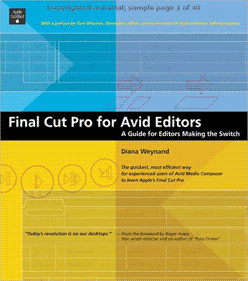
|
Final Cut Pro for Avid Editors Reviewed by Kim Fatica
Basically, much of the argument of Avid vs. Apple winds down to personal preferences and what one is most comfortable using, but this book does a wonderful job spelling out the strengths and weaknesses of both packages within the first 20 pages. Eleven pages alone are dedicated to breaking down the components of the non-linear process in chart form. This includes: Startup and Digitizing; Interface and Keyboard; Basic Editing; Moving and Trimming Edits; Audio; Transitions; Motion Effects; Compositing; Titles, Slates and Keys; Backing Up and Output. It's a wonderful comparison useful for settling a few disputes over which is the better solution. It's guaranteed to surprise any Avid fan that thought FCP was a consumer-oriented toy. Still, there will be many PC-oriented users who will scoff at the power of the Macintosh-based non-linear solution. There is an interesting bonus of having the profiles of nine high-powered professionals and their reasons for switching to FCP for certain projects, including insights on how they went about organizing their projects, shortcuts, tips and other comments readers may find applicable to their own situations. But settling arguments is not the reason to buy this book. Diversity is the key to survival in a profession that is changing rapidly and it's important for all of us to stay afloat. Knowledge is power. This book is targeted at helping Avid editors draw parallels to FCP for a smooth transition to using the package efficiently. Although the book targets Media Composer users, just about any Avid editor will benefit from this resource. Frankly, though I own both PC and Macintosh-based editing solutions and have been a Mac fan since 1988, I found this book to be a good "backwards compatible" tool for me to better understand Media Composer. Not long ago, a very close and talented friend of mine was asked to help out with the post-production of a couple major projects involving studio time outside of work using Final Cut Pro on an Apple Titanium PowerBook. Having been weaned on Avid, he hadn't a clue what he was in for. Had this book been available then, much of his anxieties would have been solved. Diana Weynand has had an esteemed career as an on-line editor for ABC in New York, later moving to Los Angeles to become the supervising editor for the Barbara Walters series of Entertainment Specials. She founded Weynand Training International in 1981 with partner Shirley Craig, the first formal training company geared towards the entertainment industry. She is the author of several other books and magazine articles on video postproduction and continues to work on cutting music videos, movie trailers and documentaries as time allows. She is a credible source and this book shines with examples of her savvy. Among the things I found most helpful were the screen shots of the features of both systems in each chapter, giving you a visual comparison of the user interface. For example, on page 100, while learning about audio effects and filters, you see Avid's EQ tool and right below it is FCP's 3 Band Equalizer. You say, "potato," I say, "potahto." Same tools, different names. That can be a very frustrating hurdle to overcome particularly when you may be searching reference manuals. On page 30, under the title "Viewing Your Sequences", you learn that Avid's Record monitor is called the Canvas in Final Cut Pro. Avid's effects are Apple's filters. All these subtle differences are minor hurdles, but are cleared effortlessly with this easy-reading reference. Though I wish this were more of an apples-to-apples (sorry for the pun) guide, meaning I wish this were more of a comparison between Xpress DV and Final Cut, it is still a great reality check for today's Digital Age. What people have forgotten (while they quibble over which OS is king) is that each one of us have the power to do so much for so little. At home. |
|
Kim Fatica began his career in television as the voice of WBGU-TV (PBS) in Bowling Green, Ohio back in 1983. His first full-time photo gig was at WWAY-TV in Wilmington, NC in 1985. Fatica came to the Cleveland market in 1986, where he is now Director of Photography at WKYC-TV. Kim Fatica has 10 Emmy Awards to his credit, including Photojournalistic Enterprise (1997) and was a runner-up for NPPA's Region 4 TV News Photographer of the Year. His freelance business, Hemlock Point Studio, has been creating video projects since 1988. |
|
home | what's new | product reviews | SPOTLIGHT | b-wear | message board | tips | job listings | market info b-roll.net ©1996-2006 Kevin Johnson |
 Some of the most popular questions I get from the Avid editors at WKYC center around their curiosity with Apple's Final Cut Pro. It isn't easy trying to convince true-blue Avid professionals that FCP is a surprisingly powerful non-linear package that can give almost any Avid digital editing solution a run for the money.
Some of the most popular questions I get from the Avid editors at WKYC center around their curiosity with Apple's Final Cut Pro. It isn't easy trying to convince true-blue Avid professionals that FCP is a surprisingly powerful non-linear package that can give almost any Avid digital editing solution a run for the money.